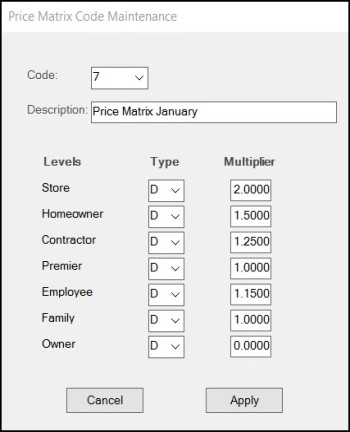Price Matrix
You can create and assign Price Matrix codes to items to calculate their prices based on a Cost or Suggested List Prices. These differ from the normal way level pricing is defined because instead of percentages, the application uses multipliers.
For example, choosing a type of "D" does not calculate using a discount percentage as it would when specifying price levels, but is instead a "Multiplier of Suggested List." This means that if you enter 1.00 as the multiplier with type "D,", the application will calculate a price that is the current Suggested List Price times 1 (in this case, the price level would equal the Suggested List Price).
An important point regarding Price Matrix codes is that although the "Type" drop down lists both Markup and Margin codes, these function exactly the same with regard to a matrix. There is no difference in the calculation when choosing a code normally used for Margin or Markup cost-based pricing. Specifically, if the same multiplier is assigned to different levels for both types M and C (Market Cost), L and R (Last Receipt Cost), or W and A (Weighted Average), the application calculates the same price. Again, it doesn't matter whether you choose the Markup or Margin Code for a specific cost type.*
*The additional types are included because they are part of a shared component.

When defining price matrices, it's also important to keep in mind that multipliers must be applied differently when using cost-based pricing vs. suggested list. Typically, a cost based price is going to use a multiplier that is higher than 1.00 (a multiplier of 1.25 is effectively a 25% markup over cost). Multipliers for suggested list pricing are typically going to be either the same as the list price or lower, so a multiplier of 1.00 or lower would be used (a multiplier of .97 is the same as a 3% discount off the list price).
Removing a Price Matrix from an Item
When you remove a price matrix from an item, the item's original pricing scheme (if the item had one) may or may not be available. If it is, you can reference the original price to replace the item's matrix multipliers. In this case, the program returns the item to its original set up prior to the matrix's addition; however, if this isn't possible, the program converts the matrix multipliers to percentages. It is always a good idea to carefully check item pricing after removing a price matrix to make sure the new prices and set up are acceptable.
Even an item's original pricing configuration exists, it may be outdated. Furthermore, the calculation to convert multipliers to percentages is very basic, so the percentages calculated don't differ based upon whether you chose a Margin or Markup code.